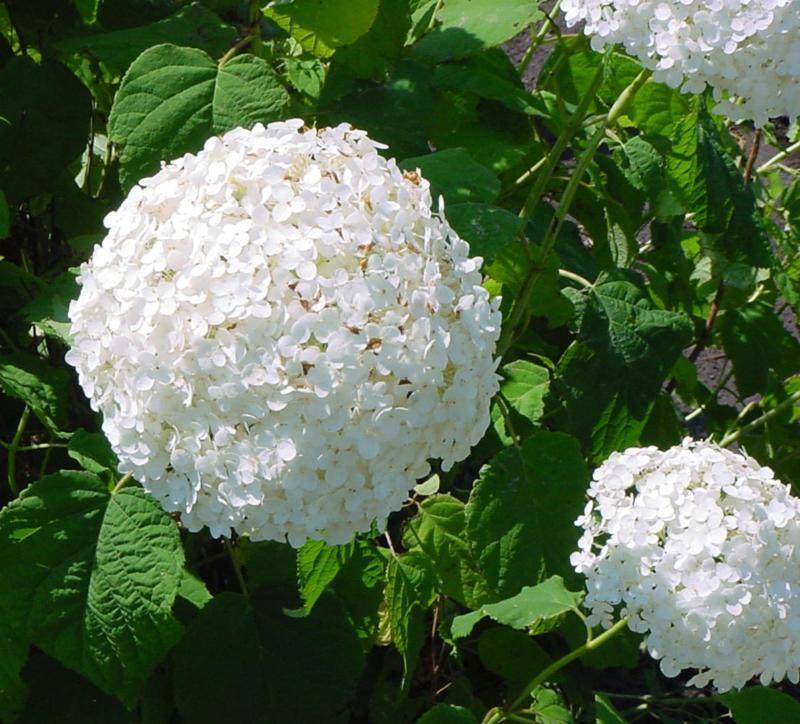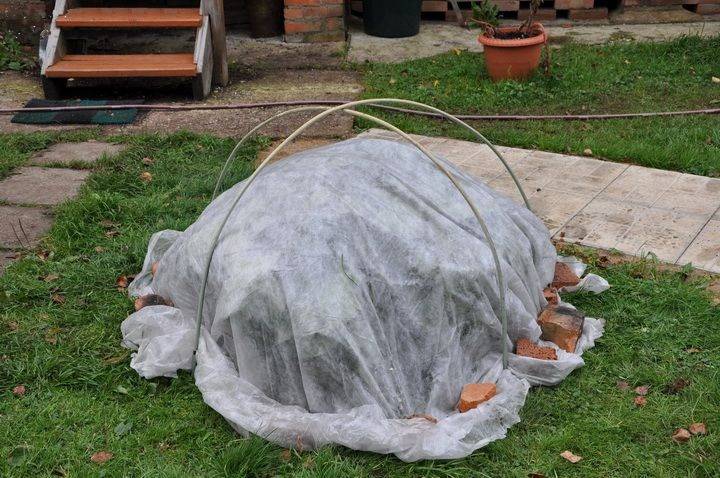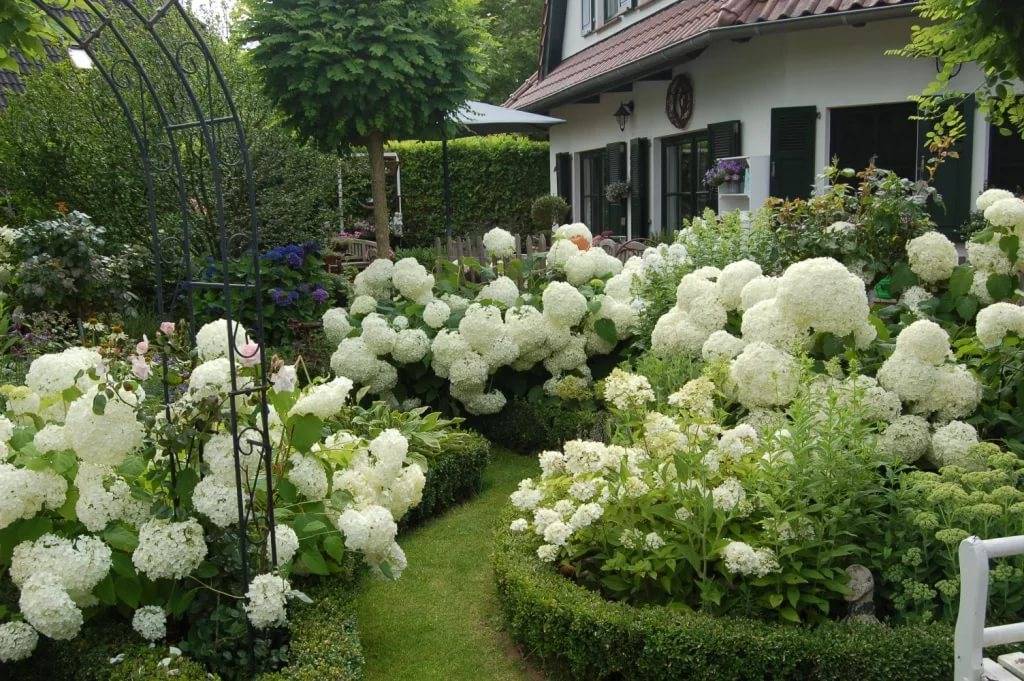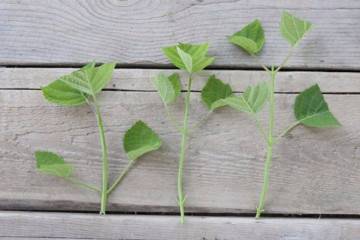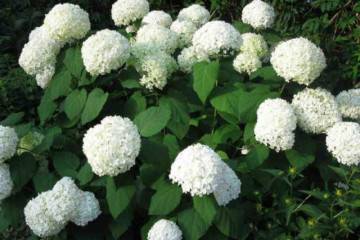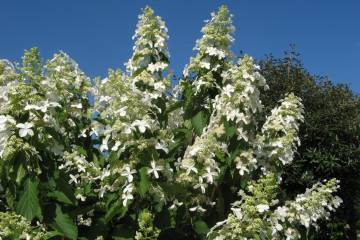Hydrangea paniculata and tree-like - differences
Content:
Hydrangea cultivation is gaining more and more popularity among gardeners. Despite the fact that warm countries are considered the homeland of the plant, some species are adapted to wintering in the middle zone, the Urals, Siberia.
Types of hydrangeas
The plant is valued not only for its unpretentious care. Hydrangeas are a real decoration of the personal plot and home greenhouse. There are many species, and they all differ in size, shape and color of inflorescences, as well as requirements for growing conditions.
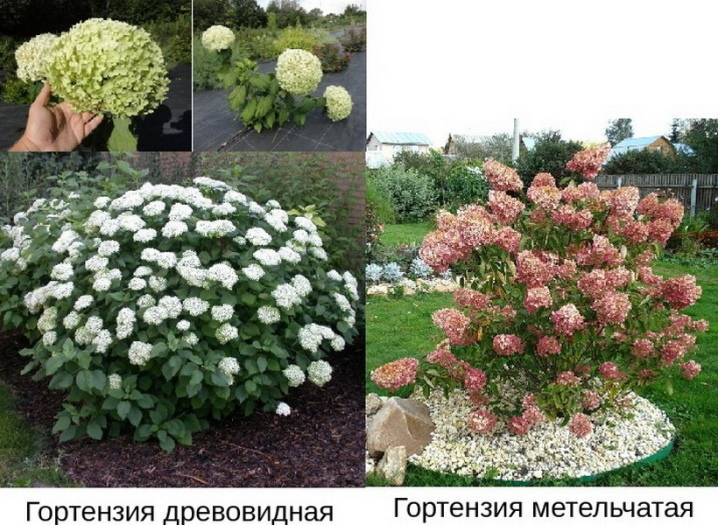
The differences between treelike and paniculate hydrangeas are clearly pronounced during the flowering period.
Currently, dozens of types of hydrangea are known:
- paniculate;
- tree-like;
- garden (large-leaved);
- oak-leaved;
- petiolate;
- variegated;
- radiant;
- ashy;
- serrated.
To choose which of the species to plant on your site, it is worth familiarizing yourself with the features of each.
Hydrangea paniculata
In conditions close to their natural habitat, the shrub reaches up to 10 m in height. Most often on the territory of Russia it is a bush with several trunks up to 2 m high. Due to the fact that the trunks have the ability to quickly lignify, this species tolerates the harsh Russian winters well.
A plant with elongated leaves, which can be either velvety or glossy, depending on the variety, and inflorescences in the form of a pyramid with a sharp top. Inflorescences are located at the tops of young shoots.
The most popular varieties: Phantom, Pinky Winky, Diamond Rouge, Vanilla Fraz, Grandiflora.
Hydrangea
Treelike hydrangea in the middle lane is a shrub 1.5 m high.Taller specimens (more than 3 m) can rarely be found. Native to North America, a deciduous shrub that winters well in regions with harsh winters.
Elliptical leaves with serrated edges are deep green in color. The back of the leaves may have a bluish tint. Smooth large leaves are up to 10 cm long.
Inflorescences are spherical or flat, the color of flowers is pink, white, purple. Formed on annual shoots.
Popular varieties: Pink Pick, Invisible Spirit, Belaya Anna.
Large-leaved hydrangea (garden)
In Russian gardens, a guest from Japan has a fairly compact size. In its natural range, it reaches a height of 3 m. In the conditions of Russian winters, such a growth cannot be achieved. Most often, large-leaved shrubs do not exceed a height of 0.5-1 m.
The plant is very decorative: the leaves are green, oblong with a pointed tip, by the end of the season they acquire a red tint. Flowers are collected in large globular inflorescences. The color of the petals depends on the acidity of the soil, and varies from white to blue and purple shades.
Popular varieties: Mini Penny, Expression, Red Sense.
How to distinguish between types and varieties of hydrangea
At first glance, the difference between plant species and varieties is expressed in the form of inflorescences, color and height of the bush.Many novice gardeners evaluate primarily the decorativeness of shrubs.
In fact, it is necessary to clearly understand how the treelike hydrangea differs from the large-leaved one, and the paniculate hydrangea from the tree hydrangea. And the point is not in decorativeness, but in the conditions that are necessary for the bush to please with lush flowering all summer.
Most varieties and species are demanding on the planting site and soil composition. The difference may also lie in the fact that varieties prefer to winter in different ways, depending on their frost resistance. Before embodying design ideas on a personal plot, you will need to familiarize yourself with the features of each type.
Hydrangea paniculata and treelike - which is better
Hydrangea paniculata and treelike is a good choice for those who wish to create a blooming oasis on their own plot. The main thing is to understand how the panicle hydrangea differs from the tree hydrangea.
The difference becomes obvious if you examine the bushes of both types, judging by the following criteria:
- External differences. In hydrangea paniculate inflorescences are cone-shaped, and in a tree-like inflorescence they are spherical. Paniculate flowers are usually larger. The decorativeness of a plant is important in order to choose the right variety for design compositions.
- Shrub structure. The tree-like one always has the shape of a bush, while the paniculate one can look like a tree.
- Frost resistance. The peculiarity of panicle hydrangea is that during the season the trunk of the bush is completely covered with bark and lignification occurs. This allows the plant to winter safely. In a tree-like cortical layer, the growth of the cortical layer is slower, and if this species is left without shelter for the winter, the plant will die.
In most regions, adult panicle hydrangea plants do not require covering measures before the winter season. Treelike requires a mandatory shelter.
The advantages of growing hydrangea paniculata on the site
When the gardener asks the question of choice, they will help to make a decision, the hydrangea is paniculate and tree-like, the differences. Having considered all the pros and cons, most growers prefer paniculata, since this plant has a number of advantages.
- In most regions, adult panicle hydrangea plants do not require covering measures before the winter season. Treelike requires a mandatory shelter.
- Feels great in shaded areas, but does not tolerate direct sunlight. A balance is needed here, since when there is insufficient light, the plant gets sick.
- A huge varietal assortment of species allows you to choose a plant for every taste.
- Unpretentious in care: watering is done 1 - 2 times a week, feeding no more than 4 times per season.
- Flowering continues throughout the summer.
Almost all types and varieties of hydrangea do not tolerate drafts and direct sunlight.
Hydrangea large-leaved and treelike
It is necessary to pay attention to the differences in species: large-leaved and tree-like hydrangea. The difference is noticeable already at the first inspection of flowering shrubs. The color of the inflorescences of the tree hydrangea is more restrained. The flowers are white, cream and pinkish. In large-leaved specimens, the color of the petals is more pronounced: white, red, purple.
In the conditions of the middle zone and in the Urals, the tree hydrangea can not be covered for the winter. Large-leaved (garden) varieties require mandatory insulation. Otherwise, the plants will die.
Crown formation occurs in different ways. Treelike inflorescences are formed on young shoots. Large-leaved subspecies forms inflorescences on shoots from the buds of last year's branches. No flowering occurs on new ones.
Summarizing all the arguments, it becomes clear that the difference between these two types lies not only in external characteristics, but also in care.
If the soil is alkaline, it affects growth and flowering. From an excess of alkalis, flowers can change color, become faded, expressionless. The plant does not tolerate alkali, and therefore it is advisable to acidify the soil.
Hydrangeas of different types in the landscape design of the site
There are a lot of options for using a plant in landscape design. It makes no sense to advise you to choose one or another variety. Each owner of the garden area prefers different varieties, focusing on his own taste.
With proper care, the shrub blooms profusely throughout the summer season, giving a good increase in green mass. In addition, the plant lends itself well to shaping.
Various compositions are created with the help of hydrangeas:
- alpine slides,
- hedges,
- framing of reservoirs and garden paths.
It is important to take into account the location of the future landing. Do not plant the plant in areas subject to drafts and direct sunlight at noon. If it is possible to create partial shade, then this option will become the most relevant. Shrubs planted in a greenhouse can be artificially shaded during periods of solar activity.
When choosing a hydrangea to decorate your own garden, first of all, you need to pay attention to the growing and wintering conditions in this region. In many of the compositions recommended by landscape designers, all three plant species common in Russia are happily coexisting.
The hydrangea will provide decorativeness and lush color without much hassle. And what kind to choose is up to the gardener.

